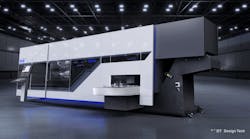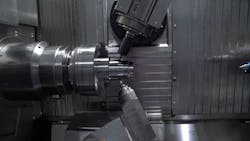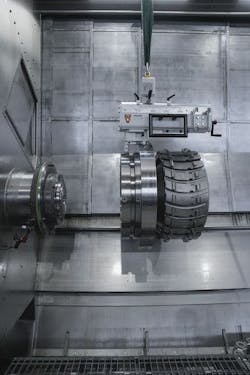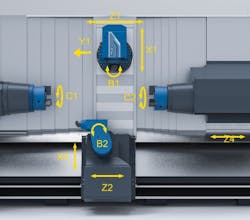When it comes to the machining of chuck parts, especially ring- and disc-shaped parts, vertical machining typically comes to mind, particularly for the convenient loading and unloading of workpieces. However, horizontal machining often creates better conditions for handling chip removal, whereby chips and cooling lubricant often remain in the workpiece.
The most important issues when it comes to producing complex chuck parts usually not only relate to the machining itself but to the loading and alignment of the parts in the clamping device. The vertical setup and alignment of the parts are also an important condition of horizontal machining. WFL has embraced this concept and challenge and is developing equipment for horizontal complete machining of chuck parts with diameters of up to 2,000 mm (Figure 1).
Clamping devices such as workpiece-specific pallets, power chucks, clamping mandrels and collet chucks can be manually or automatically changed as required. The workpiece is clamped and aligned on the clamping pallet on a vertical external clamping table or setup station. The setup station is equipped with exactly the same interface as the headstock in the form of a stable short taper mounting with a high degree of repeat accuracy. The clamping device including the workpiece can be changed automatically.
Alternatively, when using power chucks, the workpieces can be changed directly into the chuck by the robot and the workpieces can also be transferred to the counter spindle, thus enabling full six-sided machining (Figure 2).
This automation from WFL enables stable clamping with repeat accuracy, practically eliminating the need for clamping device setup times in the machine.
Depending on the machine model, additional tool carriers such as turrets are used in addition to the turning-drilling-milling unit. This second processing unit is located on the lower system. Machining can therefore take place simultaneously on both turning spindles or four-axis on one spindle at a time. On WFL machines, the integrated measuring probe is used for both horizontal and vertical machining.







